Related Research Articles

Low-alcohol beer is beer with little or no alcohol content that aims to reproduce the taste of beer while eliminating or reducing the inebriating effect, carbohydrates, and calories of regular alcoholic brews. Low-alcohol beers can come in different beer styles such as lagers, stouts, and ales. Low-alcohol beer is also known as light beer, non-alcoholic beer, small beer, small ale, or near-beer.

Pale lager is a type of beer originated in Pilsen, Bohemia Is a very pale-to-golden-colored lager beer with a well-attenuated body and a varying degree of noble hop bitterness.
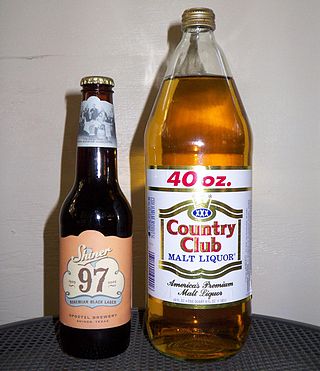
Malt liquor is a type of mass market beer with high alcohol content, most closely associated with North America. Legally, it often includes any alcoholic beverage with 5% or more alcohol by volume made with malted barley. In common usage, it refers to beers of high alcohol content, generally above 6%, which are made with ingredients and processes resembling those for American-style lagers.

Sleeman Breweries is a Japanese-owned Canadian brewery founded by John Warren Sleeman in 1988 in Guelph, Ontario. The company is the third-largest brewing company in Canada. Along with its own Sleeman brands, the company produces under licence the Stroh's family of brands, Maclays Ale and Sapporo Premium beers for sale in Canada. The company's parent Sapporo owns 4.2 per cent of Ontario's primary beer retailer The Beer Store.
The Stroh Brewery Company was a beer brewery in Detroit, Michigan. In addition to its own Stroh's brand, the company produced or bought the rights to several other brands including Goebel, Schaefer, Schlitz, Augsburger, Erlanger, Old Style, Lone Star, Old Milwaukee, Red River, and Signature, as well as manufacturing Stroh's Ice Cream. The company was taken over and broken up in 2000, but some of its brands continued to be made by the new owners. The Stroh's brand is currently owned and marketed by Pabst Brewing Company, except in Canada where the Stroh brands are owned by Sleeman Breweries.

Beer was introduced to Canada by European settlers in the seventeenth century. The first commercial brewery was La Brasseries du Roy started by New France Intendant Jean Talon, in Québec City in 1668. Many commercial brewers thrived until prohibition in Canada. The provincial and federal governments' attempt to eliminate "intoxicating" beverages led to the closing of nearly three quarters of breweries between 1878 and 1928. It was only in the second half of the twentieth century that a significant number of new breweries opened up. The Canadian beer industry now plays an important role in Canadian identity, although globalization of the brewing industry has seen the major players in Canada acquired by or merged with foreign companies, notably its three largest beer producers: Labatt, Molson and Sleeman. The result is that Moosehead, with an estimated 3.8 percent share of the domestic market in 2016, has become the largest fully Canadian-owned brewer.

The Pabst Brewing Company is an American company that dates its origins to a brewing company founded in 1844 by Jacob Best and was, by 1889, named after Frederick Pabst. It is currently a holding company which contracts the brewing of over two dozen brands of beer and malt liquor: these include its own flagship Pabst Blue Ribbon, as well as brands from many now-defunct breweries.

Beer in the United States is manufactured in breweries which range in size from industry giants to brew pubs and microbreweries. The United States produced 196 million barrels (23.0 GL) of beer in 2012, and consumes roughly 28 US gallons (110 L) of beer per capita annually. In 2011, the United States was ranked fifteenth in the world in per capita consumption, while total consumption was second only to China.
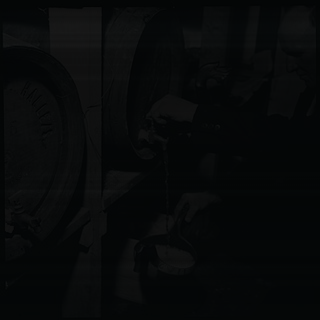
Beer in Norway has a long history, stretching back more than a millennium. Until some 200 years ago, most farms where it was possible to grow grain south of the Arctic Circle, brewed their own beer. From the early 20th century brewing was industrialized and home brewing was restricted. Significant consolidation in the brewing sector reduced the number of major breweries to just a handful. With the exception of the farmhouse ales, most beer styles brewed in Norway trace their ancestry to central Europe.

Genesee Brewing Company is an American brewery located along the Genesee River in Rochester, New York. From 2000 to 2009, the company was known as the High Falls Brewing Company. In 2009, High Falls was acquired by the capital investment firm KPS Capital. Together with newly acquired Labatt USA, KPS merged the two companies as North American Breweries. Along with this change, High Falls Brewery changed its name back to the original "Genesee Brewing Company" operating under the North American Breweries name. In October 2012, North American Breweries was purchased by FIFCO.

Beer in Japan mostly comes from the country's four major breweries, Asahi, Kirin, Sapporo and Suntory, which mainly produce pale lagers around 5% ABV. Beer is immensely popular, far ahead of sake consumption.
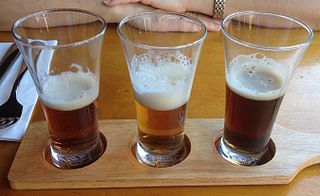
Beer styles differentiate and categorise beers by colour, flavour, strength, ingredients, production method, recipe, history, or origin.

The G. Heileman Brewing Company of La Crosse, Wisconsin, United States, was a brewer that operated from 1858 to 1996. It was ultimately acquired by Stroh's. From 1872 until its acquisition, the brewery bore the family name of its co-founder and brewer Gottlieb Heileman.

The U.S. state of Vermont is home to several breweries, microbreweries, nanobreweries, and brewpubs that produce a wide variety of beer.
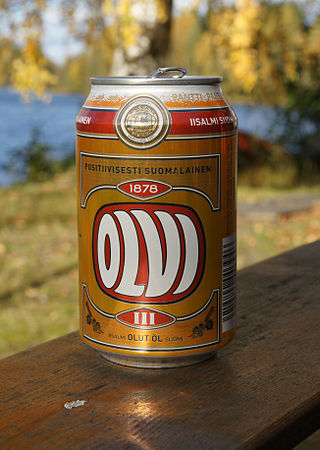
Finland has a long history of beer dating back to the Middle Ages. The oldest still-existing commercial brewery in Finland and Nordic countries is Sinebrychoff, founded in 1819. The Finnish Beer Day is celebrated on 13 October to commemorate the founding of the Sinebrychoff brewery and the birth of Finnish beer. The largest Finnish brewers are Hartwall, Olvi and Sinebrychoff. Most of the beers brewed in Finland are pale lagers. Finland's standing is 9th in per capita consumption of beer. Finnish people consume a total of 440 ML of beer annually and the trend is increasing by 11.7 633 mL bottles year-on-year per capita.
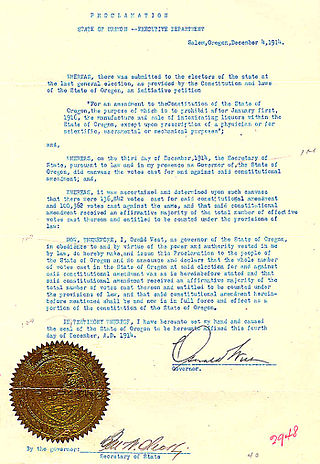
The U.S. state of Oregon has an extensive history of laws regulating the sale and consumption of alcoholic beverages, dating back to 1844. It has been an alcoholic beverage control state, with the Oregon Liquor and Cannabis Commission holding a monopoly over the sale of all distilled beverages, since Prohibition. Today, there are thriving industries producing beer, wine, and liquor in the state. Alcohol may be purchased between 7 a.m. and 2:30 a.m for consumption at the premise it was sold at, or between 6 a.m. and 2:30 a.m. if it is bought and taken off premise. In 2020, Oregon began allowing the sale of alcohol via home delivery services. As of 2007, consumption of spirits was on the rise while beer consumption held steady. That same year, 11% of beer sold in Oregon was brewed in-state, the highest figure in the United States.

American lager or North American lager is pale lager that is produced in the United States. The pale lager-style beer originated in Europe in the mid-19th century, and moved to the US with German immigrants. As a general trend outside of Bavaria and the Czech Republic where the beers may be firmly hopped, pale lager developed as a modestly hopped beer, and sometimes used adjuncts such as rice or corn – and this was also true in the US.
The production of beer in New Jersey has been in a state of recovery since Prohibition (1919-1933) and the Great Depression (1929-1945). Currently, the state has 123 licensed breweries: a large production brewery owned by an international beverage company, Anheuser-Busch InBev, and 122 independent microbreweries and 19 brewpubs. The growth of the microbreweries and brewpubs since the 1990s has been aided by the loosening of the state's licensing restrictions and strict alcohol control laws, many of which were a legacy of Prohibition.

Beer has been brewed in Sri Lanka from five hundreds of years. In the 19th century, the British introduced British beer to Ceylon. The most popular beers in Sri Lanka are Lager-style beer.
References
- ↑ Mittelman, Amy (2008). Brewing Battles: A History of American Beer. New York: Algora Publishing. p. 28. ISBN 978-0875865744. OCLC 845157387.
- ↑ Mittelman 2008, p. 30.
- 1 2 Bamforth, Charles (2009). Beer: Tap into the Art and Science of Brewing. New York: Oxford University Press. pp. 1–272. ISBN 978-0199756360. OCLC 911235053.
- ↑ Mittelman 2008, p. 37.
- ↑ Gately, Lain (2009). "30". Drink: A Cultural History of Alcohol. New York: Gotham Books. p. 317. ISBN 978-1592404643. OCLC 384893192.
- ↑ Mittelman 2008, p. 45.
- ↑ Mittelman 2008, p. 79.
- ↑ "C.W. Feigenspan, Newark Brewer; President Of Company Dies At His Rumson Home. Fought The Dry Amendment. Firm Was Founded in 1868. Father Started Business In A Cellar. Ex-Head Of Federal Trust Co. in Newark". The New York Times . February 7, 1939. ProQuest 102745050.
- ↑ "Members". Beer Institute . Archived from the original on 25 March 2013. Retrieved 17 January 2022.